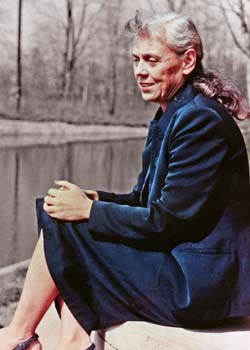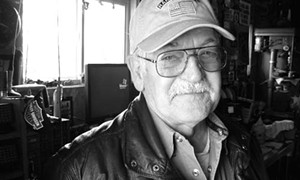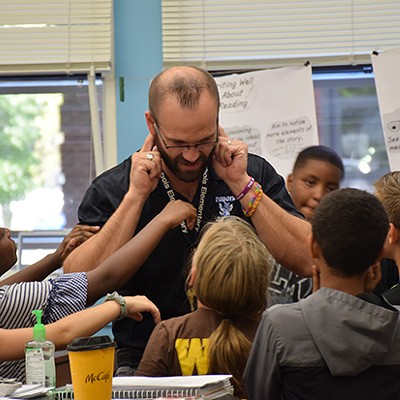The documents, including diaries, journals, manuscripts, and approximately 2,000 letters, chronicle the life and work of Lowney Handy, who founded a writers’ colony in the eastern-Illinois town of Marshall. Between 1950 and 1964, she tutored more than 100 writers, including her premier pupil, James Jones, the author of From Here to Eternity, arguably the most famous novel to come out of World War II. “Whether they were great writers is almost not even the point,” says Chicago filmmaker Dawn Sinclair Shapiro, who labored for three years making a documentary on the subject. Inside the Handy Writers’ Colony is slotted to air nationally on the PBS television network later this year. Shapiro used materials from the UIS collection to help reveal the complicated relationship between Jones and his mentor and explain how that collaboration grew into a Midwestern literary school. Altogether, the colony spurred the publication of a dozen novels. Four of the books were adapted into Hollywood movies. The Handy Writers’ Colony didn’t follow in the tradition of other touted retreats on the East Coast that catered to established authors and poets. Instead, Lowney was interested in training less experienced and often disadvantaged writers. She bragged that she could mold anyone into a great writer if he or she would follow her advice. Her prospects included disgruntled veterans, dropouts, and ex-cons.
“She believed in them,” Shapiro says. “She believed in their work. There is something to be said about that, when someone believes in you.”
The first writer Lowney believed in was Jones, who had joined the Army in 1939 after graduating from high school in Lowney’s hometown of Robinson, Ill. Jones was stationed at Schofield Barracks in Hawaii on Dec. 7, 1941, when the Japanese attacked Pearl Harbor. He later saw combat in the South Pacific, at Guadalcanal, before injuring his ankle and being shipped stateside. After his return, Jones convalesced at the Kennedy General Hospital in Memphis with other recovering soldiers. Over the next few months his ankle mended, but his battle-scarred psyche did not. Both of his parents had died while he was away. His combat experience had alienated him, and Jones increasingly exhibited symptoms of what would later be diagnosed as posttraumatic stress. On leave from the hospital, he facilitated his drinking and philandering by booking a room at the Peabody Hotel for six weeks. His bouts at the hotel bar often ended in brawls.
When the Army ordered him back to active duty in August 1943, Jones went on another binge and was briefly absent without leave, but he returned to Fort Campbell, Ky., where his newly assigned unit was being readied for the forthcoming D-Day invasion of Europe. In November he went AWOL a second time, taking refuge at the home of his uncle Charles Jones, a conservative attorney in Robinson. At a birthday celebration held on his behalf at the Elks Club, Jones drunkenly insulted some of the town’s leading citizens, embarrassing his uncle. Concerned over his drinking and anti-social behavior, Charles Jones’ wife introduced James Jones to Lowney Handy, a neighbor who worked with troubled youth.
The meeting would forever change both their lives.
Years later, Lowney gave her first impression of Jones in a story that appeared in Life magazine: “He swaggered; he wore dark glasses; he even asked me to read his poetry out loud. He had obviously come over for a drink. Then he saw my books. . . . He flipped through them and plopped them back as if he were gulping down what they had in them. So I asked him if he’d like to see my writing room.”
Lowney, a fledgling writer herself, became Jones’ mentor. She also became his lover, though that aspect of their relationship was not mentioned in the Life article. She was 17 years older than Jones. During the course of their 15-year affair she remained married to Harry Handy, a superintendent at the Ohio Oil Co. refinery in Robinson. When Jones went AWOL the final time, in May 1944, Lowney coaxed him into returning to his Army base to face disciplinary action. She then began lobbying the military bureaucracy for leniency on his behalf. On the basis of a series of psychiatric evaluations the Army finally determined that Jones was “psychoneurotic” and granted him an honorable discharge in July 1944.
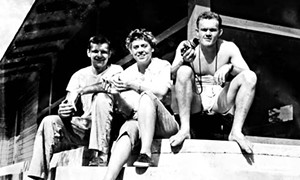
Jones went back to Robinson to live with the Handys at 202 W. Mulberry St. While she provided emotional support and literary guidance, her husband paid the bills. The Handys added a room to their house for Jones to use as his study. They also bought him a house trailer and a jeep to use for road trips out West and to Florida. For the next several years Jones worked on his first novel, They Shall Inherit the Laughter, and later wrote much of From Here to Eternity while living with the couple.
“My own view is that From Here to Eternity would certainly not have been written if Jones had not had Lowney and her husband,” says George Hendrick, a James Jones scholar at the University of Illinois at Urbana-Champaign. “He was a great writer, but he needed help.”
Lowney received no accolades in her hometown for her efforts, however. “There were a lot of people in town who thought she was the town whore,” says 81-year-old Helen Howe of Robinson, a longtime friend, “but she didn’t worry about other people’s attitudes toward her, so long as she was satisfied. At that time, you couldn’t find that many women who could afford to be that independent.
“Harry didn’t care,” Howe adds. “The relationship between Lowney and her husband couldn’t have been better. He had been having affairs for years. Harry had a girlfriend for as long as I knew him, and it was the same girlfriend. At the time, it was not that unusual in Robinson.”
An open marriage flourishing in a small Midwestern town contradicts the stereotype often associated with 1950s America, but the Handys’ less-than-perfect union had been forged much earlier. Before their 1926 nuptials, Harry allegedly paid for Lowney to have an abortion and then married her out of guilt. He later contracted gonorrhea and passed it to his wife. As a result she had to undergo a hysterectomy, and the couple remained childless. Lowney founded the writers’ colony in 1950 in Marshall on five acres of land owned by Harry Handy’s mother. Initially her literary recruits bivouacked in tents. Barracks and other improvements, including the construction of a swimming pond, came later. In the early years Jones lived on the premises in his shiny aluminum Spartan Airstream house trailer. Lowney spent the summers in a nearby cottage. The colony operated from spring through fall. In the winters Lowney and Jones would live together in Florida or Arizona, where she often invited her most promising acolytes to join them. At first, most of her students were young men who lived nearby, but after the publication of the Life article in May 1951 they began flocking to the colony from all over the country. They ranged in age from their late teens to their early thirties. Lowney’s published novelists included Tom T. Chamales, Jerry Tschappat, Edwin Daly, Charles Wright, William Duhart, Jere Peacock, and Jon Shirota.
An applicant’s desire to write was deemed the most important criterion for acceptance, followed by a willingness to adhere to Lowney’s strict regimen. In return, she asked that novelists pay her 10 percent of their future royalties from books written at the colony. She believed that a writer’s creativity could not be tapped unless the writer had first been stripped of his ego. One way of achieving this goal, according to Lowney’s method, was through isolation. Once a writer entered the colony, much of his contact with the outside world was cut off. Newspapers, radios, and television were prohibited. Inside the gates, members led essentially a monastic existence. They rose at 5:30 a.m. and had a breakfast of toast and coffee in silence at the ramada, the name for the building that housed the screened-in kitchen and dining area. Afterward they returned to one of the two barracks, which were divided into 12 small rooms. Each room contained a cot, chair, table, typewriter, and lamp. In these austere quarters, writers would work on their assignments until noon. Before graduating to writing their own novels, members of the colony were required to copy the works of noted authors. The objective was to subconsciously instill in the student the style of the writer whose work was being copied. Lowney selected the copying exercises on the basis of the perceived weaknesses of the student’s own writing. Writers of long, florid prose were forced to copy the terse style of Ernest Hemingway. Conversely, those who found themselves short of words were required to copy William Faulkner. The works of Marcel Proust, D.H. Lawrence, Dylan Thomas, and T.S. Eliot were forbidden because she considered them too intellectual and “sissy-like.”
Once freed to pursue their own writing, Lowney’s charges were encouraged to write short “skits,” or scenes, which later would be stitched together to form novels. She also prohibited writers from talking about their novels with anyone except her. After a bland lunch, which often included cottage cheese or shots of liquid Jell-O, everyone was expected to labor for a few hours on various projects to improve and maintain the grounds. Writers spent the remainder of the afternoon reading or participating in recreational activities. After dinner, her wards were allowed to socialize until 9 o’clock, when they retired for the evening. With few exceptions, women were excluded from joining the colony and banned from visiting. Their mere presence, according to Lowney, might distract her male writers. In general, she took a harsh view of her own sex. “A woman is the most cold-blooded creature on earth when it comes to selecting a man,” Lowney allegedly told one of her star pupils. “You poor sons-of-bitches. You think women are delicate and need protection, but that’s a myth created by a matriarchal society. Women have you by the balls, all of you, and you never have figured it out. . . . A man who gets married and becomes a householder will never be an artist.”
Jones, the established artist of the bunch, drew attention to his nonconformity by roaring through Marshall on a Harley-Davidson in a black leather jacket. On another occasion he reportedly sallied downtown shirtless, wearing shorts, sandals, and a leather-fringed vest, with silver-and-turquoise bracelets dangling from his wrists. Nobody questioned his flamboyant attire, perhaps because of the pearl-handled pistols holstered on his hips. But rumors proliferated. Locals suspected the colony of being a demonic cult or a collective of homosexuals. In the summer heat, the writers frequently wore swimming trunks and little more, leading to further speculation. “It was viewed by some as a nudist colony and a colony full of nut cases,” says 71-year-old Kenny Snedeker, a Marshall native who joined the colony in 1954 after graduating from high school. “None of that is true, of course.”
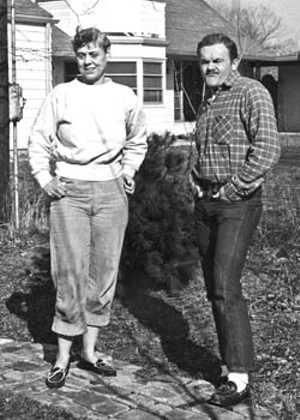
After sating their hedonistic desires, the writers returned to the ascetic atmosphere of the colony, where their indoctrination continued. Writing may have been the major subject at the colony, but Lowney’s personal philosophy was also part of the courseload. She peppered her literary advice with biblical quotations and wrote about karmic consequences in her letters. She meditated, practiced yoga, studied Eastern mysticism, believed in reincarnation, and recommended that her students give themselves enemas to cleanse their systems of impurities. Her eccentricities and avant-garde beliefs preceded the New Age movement by decades. She went braless and wore sweatshirts, barking commands and extolling praise. Colonists opposed her edicts under threat of banishment. Many left of their own volition, unable to adhere to the strict rules. In a later era, the colony might have been considered a hippie commune but for the fact that Lowney loathed long locks. She also frowned on facial hair, with the exception of Jones’ military mustache. “She was a self-made person,” Snedeker says, “self-educated and very well read. She ran it [the colony] like any Army base. You knew what the limits were. She could be very sweet or she could curse you out like a sailor, if you crossed her, but it was a pleasant place. I never had any problems, whatsoever.”
Others remembered their stays less fondly. In his 1971 memoir, The Colony, John Bowers described the conditioning as similar to experiments endured by Pavlov’s fabled dog. “We never knew when our masters’ anger would be turned against us,” wrote Bowers. “Like dogs we might run to them, wanting to be petted — and find ourselves being beaten because they were in a bad mood. Things had a way of happening between them, things we knew nothing about, that would cause them to lash out for no reason we could understand.”
During his term at the colony, Lowney wrote Snedeker a rambling missive. The typewritten letter is filled with sentence fragments, advice, and aphorisms, the kind of disjointed encouragement she offered many aspiring writers. But in retrospect, Lowney’s opening paragraph now seems to reveal as much about her personal struggle as it does about how to write well: “Conflict is the key to writing. People with problems. DUALITY. Internal inconsistency, which is the note of evil, the destruction of the Garden of Eden. . . . ”
Snedeker, who was 17 years old at the time, says that he was unaware of Lowney and Jones’ affair — “but I would notice real late at night, like maybe around 11 o’clock, that I’d see Lowney slip over to his house.” He didn’t learn the reason for the nocturnal visits until years later. More discerning colony members felt caught in the middle. Bowers wrote that a fellow writer explained the situation to him this way:
“There are games being played here I don’t understand, and I’d just as soon be left out. I have the distinct feeling that this whole thing — the Colony, everything — is just something between Jim and Lowney and that we’re only here as stagehands.”
After the success of From Here to Eternity, Jones sold the movie rights and contributed an estimated $60,000 to $100,000 of his newfound wealth to the colony. In early 1952, he accepted the National Book Award in New York, where he hobnobbed with novelist Norman Mailer and other leading literati. As Jones’ career ascended, his younger sister’s life slid closer to the abyss. Mary Ann Jones had been in freefall since adolescence, when she discovered the body of their alcoholic father, a dentist, on the floor of his office in Robinson. Ramon Jones had died of self-inflicted gunshot wounds to the head. Mary Ann was 17 years old. Their mother had died a year earlier. As Mary Ann grew into adulthood, her behavior became increasingly erratic. She drank heavily and abused drugs. After an unsuccessful stab at being an actress in Hollywood, Mary Ann began writing. Making an exception to her exclusionary rule, Lowney admitted Mary Ann to the colony. Her autobiographical novel The Third Time You Killed Me was nearing completion when she was found dead on the floor of her trailer on June 5, 1952. Charles Jones, who disapproved of his niece and nephew’s lifestyle, suspected foul play and requested that the U.S. marshal in Danville, Ill., oversee a coroner’s inquest. The inquest, however, found that Mary Ann had died of natural causes as a result of a seizure caused by a brain tumor.
Within days of Mary Ann’s funeral, life at the colony seemingly returned to normal. Later that summer, Mailer visited. He arrived driving a sporty Studebaker with wire wheels, his future wife, the raven-haired beauty Adele Morales by his side. Actor Montgomery Clift also dropped by. Clift had met Jones after being cast in a leading role in the movie adaptation of From Here to Eternity.
Despite the broadening of his social network, Jones showed no signs of wanting to leave Marshall or Lowney. In late 1953 he moved into a custom-built $85,000 bachelor pad located next to the colony’s grounds. His new digs included a cathedral ceiling, lavish Philippine mahogany, and a bidet. But he kept the same arduous schedule six days a week, working each morning on his next novel, Some Came Running, a 1,200-page opus devoted to the hypocrisies of life in a small Midwestern town. In December 1956, Jones went to New York to meet with his publisher. While there, writer Budd Schulberg introduced him to Gloria Mosolino, a stand-in for Marilyn Monroe in the feature film The Seven-Year Itch. After a whirlwind romance, Jones and Mosolino were married in Haiti on Feb. 27, 1957. Lowney, in Florida for the winter, had already sent a congratulatory telegram, but she could not contain her jealousy. In a letter to Harry, she referred to the bride as “Gloria Vanderbilt Mussolini.”
A few months later the newlyweds arrived in Marshall, intent on setting up housekeeping. Jones still hadn’t told his wife the truth about his relationship to Lowney, but she had her suspicions, and tensions rose. Finally Lowney’s anger erupted over the Fourth of July holiday.
Gloria’s nieces, 10 and 12 years old, were visiting at the time. In the new documentary, they publicly recount the incident for the first time.
“She had the knife like this,” says Kate Sotiridy, holding her clenched fist over her head. “She just cut the screen and . . . and barged in and came after Gloria with the knife.”
According to James Jones’ biographer Frank MacShane, Lowney shouted: “The only reason Jim married you is that you’re the best cocksucker in New York!” The two women fell to the floor, punching and scratching each other until Jones separated them. Jones and his wife left the next day, and Jones never returned. In 1958 the couple moved to Paris, where they lived for the next 15 years in self-imposed exile. They had two children. Jones would go on to write other novels, including The Thin Red Line, based on his combat experiences at Guadalcanal. He and Gloria would entertain a cast of celebrities and visiting authors at their Paris apartment. But he never wrote another book as successful as From Here to Eternity. For her part, Lowney continued to work with aspiring writers, but the colony slowly declined. In later years she provided guidance mainly through correspondence, but she was still instrumental in getting her students’ novels published. After her husband’s death, in 1963, her health declined rapidly, and she died on June 27, 1964. She was 60 years old. The Handys are buried side by side in the Marshall Cemetery. None of Lowney’s cherished writers attended her funeral.
At the end of the forthcoming documentary, the narrator reads from a letter by Jones dated Jan. 27, 1949. He is writing to Lowney from Robinson, where he is spending the winter with Harry at the Handy residence on West Mulberry Street. Lowney is in Tampa, struggling to write her own novel, which she ultimately burns on the beach. The letter expresses Jones’ angst at their separation. He credits Lowney with helping him write From Here to Eternity. Jones attempts to explain their ménage à trois in psychological terms, slipping back and forth from a hypothetical situation to their own. In his analysis he describes a power struggle, a war of sorts, in which each combatant vies for domination. Jones says that he longs to transcend that battle — but he also muses about using their relationship as material for a future book.
I’ll be able to write a great love novel someday, don’t you think? It will end as a tragedy, of course. But yours and mine must not end that way. It has been too great a thing for both of us. It has made both of us, though it nearly destroyed us both a thousand times.
Jones will always be remembered for his realistic portrayal of military life and the impact of war on men’s souls. Though elements of Lowney’s personality found their way into his female characters, he never wrote that great love novel. Instead, his letters to Lowney are his tribute to tragic love.
There is no joy in life without love, everything is drab, meaningless. I’d just as soon not be alive, as not have your love.
Forevermore, Jim
C.D. Stelzer is a frequent contributor. His story about John Larry Ray, “The assassin’s brother,” appeared in the Nov. 29 issue.

